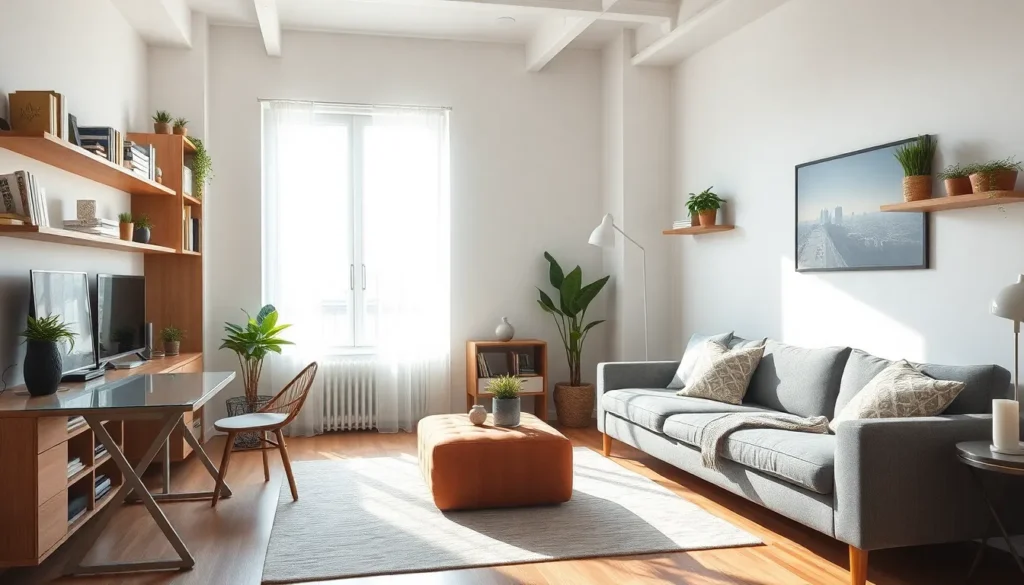Table of Contents
ToggleIn a world where urban living spaces are shrinking, space-saving designs are becoming essential for maximizing functionality without sacrificing style. These innovative solutions transform cramped areas into efficient havens, proving that less really can be more. From multi-functional furniture to clever storage ideas, space-saving designs cater to modern lifestyles that demand versatility.
As people seek to create comfortable and organized environments, the demand for smart design solutions continues to grow. Whether it’s a tiny apartment or a cozy home office, embracing space-saving concepts can lead to a more harmonious living experience. Discover how these ingenious designs can revolutionize any space, making it not just livable but also enjoyable.
Overview Of Space-Saving Designs
Space-saving designs focus on maximizing functionality in limited areas. These concepts often utilize innovative strategies, such as multi-functional furniture and intelligent storage solutions. Multi-functional furniture includes items like fold-out tables, sofa beds, and expandable desks. These pieces serve multiple purposes, reducing the need for additional furnishings.
Clever storage ideas play a crucial role in efficient space use. Utilizing vertical space, such as wall-mounted shelves or cabinets that reach the ceiling, significantly increases storage capacity. Under-bed storage and built-in furniture optimize available space, providing discreet storage options without cluttering the environment.
Pop-up furniture, which transforms when needed, also enhances usability. Pieces like stackable chairs and nesting tables offer convenience without sacrificing style. Modular furniture systems provide customization, making it easy to adapt layouts as needs change.
Incorporating minimalistic design principles further enhances space-saving efforts. Clean lines and a decluttered aesthetic promote openness and reduce distractions. This approach allows for both visual and physical expansion, making small areas feel more spacious.
Overall, the integration of these design concepts contributes to improved livability and enjoyment in various spaces, responding to the demands of modern urban living.
Benefits Of Space-Saving Designs

Space-saving designs offer numerous advantages that enhance both utility and comfort in smaller environments. These benefits significantly improve the overall living experience.
Enhanced Functionality
Enhanced functionality defines the core appeal of space-saving designs. Multi-functional furniture, like sofa beds and extendable tables, optimizes space by serving various purposes. Integrated storage solutions, such as ottomans with hidden compartments and wall-mounted shelves, add usability without extra footprint. Modular furniture adapts to changing needs, allowing residents to rearrange spaces quickly. Smart design transforms limited square footage into highly usable areas, promoting efficient living.
Increased Comfort
Increased comfort greatly benefits from well-executed space-saving designs. A minimalist approach reduces visual clutter, making spaces feel more open and airy. Comfortable furniture, such as ergonomic chairs and adjustable desks, support both relaxation and productivity. Thoughtful layout planning ensures easy movement and access to necessities. Customizable solutions cater to individual preferences, resulting in personalized and inviting environments. Such designs foster a sense of well-being, making compact living more pleasant and enjoyable.
Popular Space-Saving Design Ideas
Space-saving design ideas focus on maximizing efficiency and functionality in compact areas. These solutions combine clever layout strategies with innovative furniture and storage options.
Multi-Functional Furniture
Multi-functional furniture maximizes usability in small spaces. Examples include:
- Sofa Beds: Combine seating and sleeping areas, perfect for accommodating guests in limited space.
- Expandable Tables: Adjust size for dining or work purposes, adapting to various needs without consuming extra space.
- Ottoman Storage: Provides seating or a footrest while offering concealed storage for blankets and miscellaneous items.
- Murphy Beds: Fold up against the wall, freeing floor space when not in use, ideal for studio apartments or guest rooms.
- Nesting Tables: Stack together for compact storage, serve as side tables when needed, and require minimal space.
Innovative Storage Solutions
Innovative storage solutions enhance organization and efficiency. They include:
- Vertical Shelving: Utilizes wall space for books and decor, keeping floors free of clutter while creating visual interest.
- Under-Bed Storage: Offers discreet storage options for seasonal items and footwear, maximizing often-overlooked areas.
- Hooks and Racks: Install on walls to store coats, bags, and accessories, optimizing accessibility while saving floor space.
- Hidden Compartments: Incorporate concealed spaces in furniture, like coffee tables or benches, to hide away items without sacrificing style.
- Modular Systems: Allow for flexible configurations, adapting to personal needs and ensuring efficient use of available space.
These space-saving design ideas contribute to a more organized and functional living environment, addressing the challenges of urban living and small spaces.
Tips For Implementing Space-Saving Designs
Effective implementation of space-saving designs involves strategic choices and smart planning. These considerations maximize functionality while creating an inviting atmosphere.
Maximizing Vertical Space
Utilizing vertical space significantly enhances storage and display options. Install wall-mounted shelves for books, decor, and essentials, clearing floor space. Use tall cabinets that reach the ceiling to maximize storage without occupying additional square footage. Incorporate hooks and pegboards for hanging items, which keeps surfaces uncluttered. Consider vertical garden systems or wall planters for greenery without sacrificing floor space. Employing these methods not only adds functionality but also draws the eye upwards, creating an illusion of higher ceilings.
Choosing the Right Color Palette
Selecting an appropriate color palette directly influences the perception of space. Light and neutral colors, such as whites, creams, and pastel tones, make areas feel airy and expansive. Dark colors, while stylish, can create a sense of confinement; hence, they work best as accents rather than dominant hues. Implement monochromatic schemes to maintain visual consistency, encouraging seamless flow between spaces. Combine complementary colors through textiles or artwork to infuse personality without overwhelming the area. These color strategies contribute to a cohesive look, making small living spaces feel more spacious and engaging.
Space-saving designs are essential for modern living, especially in urban settings where space is at a premium. By embracing multi-functional furniture and innovative storage solutions, individuals can create environments that are both stylish and practical. These designs not only optimize functionality but also enhance comfort, making small spaces feel more inviting and organized.
Implementing strategic choices, such as maximizing vertical space and selecting a thoughtful color palette, can significantly improve the livability of compact areas. As the demand for efficient living solutions grows, adopting these design principles will transform how people experience their homes, ultimately leading to a more enjoyable and fulfilling lifestyle.




